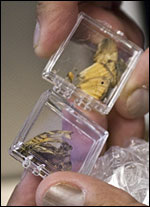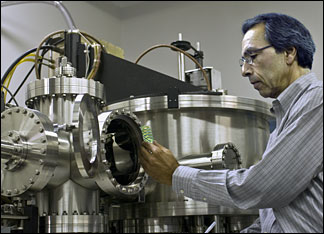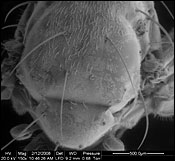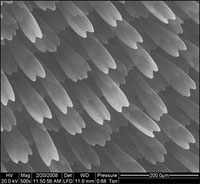
Coating Copies Biosurfaces
UNIVERSITY PARK, Pa., Sept. 17, 2008 -- A thin coating of glass has been used to rapidly and inexpensively copy the micro- and nanostructure of biological surfaces to exploit properties such as light interaction, thermal ability and adhesion.
The research could one day lead to cars with an insect-like metallic finish, or the deep black of a butterfly's wing, with reflectors patterned after the nanostructure of a fly's eyes, according to Penn State researchers who have developed the method.
Butterflies, flies, flower petals, leaves and other plants and animals may one day become the template for ultrathin coatings of glass, polymers and other materials that have unusual optical, thermal and surface characteristics. (Photo: Greg Grieco, Penn State)
"Only a small fraction of mutations in evolutionary processes are successful," said Akhlesh Lakhtakia, the Charles Godfrey Binder Professor of Engineering Science and Mechanics. "But evolution has gone on for at least a billion years. A huge range of biological surface architectures have been created and are available."
Lakhtakia and his colleagues used the conformal evaporated film by rotation (CEFR) technique to produce coatings that capture the micro- and nanostructure of biological surfaces in a thin coating of glass. Assisting Lakhtakia were Carlo G. Pantano, distinguished professor of materials science and engineering, and director of Penn State's Materials Research Institute, and Raúl J. Martín-Palma, Penn State visiting professor and professor in the department of applied physics, Universidad Autónomia de Madrid.
Lakhtakia holds containers of butterfly wings that will be coated with chalcogenic glass using the conformal evaporated film by rotation (CEFR) technique. (Photo: Greg Grieco, Penn State)
In the CEFR technique, the researchers thermally evaporate the material that forms the coating in a vacuum chamber. The object receiving the coating is fixed to a holder and rotated about once every two seconds. The researchers have coated butterfly wings and a fly, creating replicas of these templates with identical surface characteristics. The researchers are using chalcogenide glasses composed of varying combinations of germanium, antimony and selenium.
"With the right temperature, which is room temperature, and the right pressure and rotation speed, the coating process takes about 10 minutes and deposits a 500- nanometer layer," said Lakhtakia.
Some biostructures, such as moth's eyes, which are duplicated to produce moth's-eye lenses, can be mechanically created by engineers, but it is painstaking and expensive work. These lenses, that capture nearly all available light, have applications in optoelectronic and photovoltaic applications. Other biostructures do not lend themselves to synthetic reproduction.

Carlo G. Pantano, distinguished professor of materials science and engineering, and director, Penn State's Materials Research Institute holds conventional doubly refracting glass which requires 15 or more alternating layers of two materials with precisely controlled thicknesses. The CEFR technique yields doubly refracting characteristics through deposition of only one coating, nanostructured by the biotemplate. He stands before equipment used for this technique. (Photo: Greg Grieco, Penn State)
"In that case, perhaps we need to replicate the actual structure," Lakhtakia said. "One insect has an iridescent shell that does not change colors as many shiny ones do. No one has made this type of material artificially because we do not know the mechanism by which it retains its color, but making a template from the actual insect would replicate the fine structure of the surface."
Many things in the natural world are colored not by pigment, but by surface structure. The way light interacts with the surface creates the color, rather than any tint or chemical. Reproducing the surface reproduces the color. Surface properties include not just visible light characteristics, but also infrared, thermal, stickiness (adhesion) and other characteristics.
Martín-Palma, Pantano and Lakhtakia's work creates either a replica template or a mold depending on what they coat. The replica of a template can be used to create a mold in a harder, less damageable material to make many copies. Molds can be combined and multiplied to create the desired surfaces.

The magnified head of a fly coated with chalcogenic glass. (Image: Carlo Pantano/Akhlesh Lakhtakia, Penn State)
The researchers initially looked at surfaces with optical properties because they are easy to see and identify. The structural black of some butterflies invites investigation of thermal properties as well. Creating surfaces that have micro- or nanoscale patterns on solar cells, heat exchangers, reflectors and lenses can produce devices that work more efficiently.
"The whole world of biomimetics and bioinspiration is just beginning to emerge," Martín-Palma said. "Butterfly wings come in a large variety of surface structures. Eventually we may be able to take these biological structures and modify them to create other properties that do not already exist on biological surfaces."
While the researchers are still experimenting with butterfly wings, they would like to use CEFR on lotus leaves because they are superhydrophobic. Surfaces that repel water could be very useful; Researchers at the Georgia Institute of Technology has mimicked the lotus leaf, one of nature’s best nonstick surfaces, to help create more reliable electric transmission systems, photovoltaic arrays that retain their efficiency, MEMS structures unaffected by water and improved biocompatible surfaces able to prevent cells from adhering to implanted medical devices (See Self-Cleaning Lotus Mimicked for PV Arrays, Nonstick MEMS). 
Enlarged view of surface of butterfly wings after application of coating using CEFR. (Image: Carlo Pantano/Akhlesh Lakhtakia, Penn State)
The Penn State team also plans to look at other plant materials as potential surfaces for solar cells. Lakhtakia and Martín-Palma are organizing a small conference next year on biomimetics and bionispiration.
Pantano suggested the use of chalcogenide glass for its infrared properties, but the researchers have also tried other glasses and materials like polymers to reproduce other surfaces and their properties. This research was supported by the Ministerio de Educacion y Ciencia (Spain) and the Penn State National Science Foundation National Nanotechnology Infrastructure Network. The researchers have filed a provisional patent application on this work. The results appeared in recent issues of Applied Physics Letters and Nanotechnology.
For more information, visit: www.psu.edu
Published: September 2008